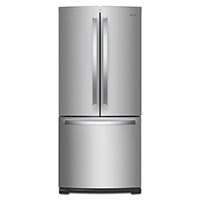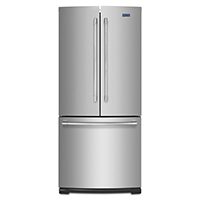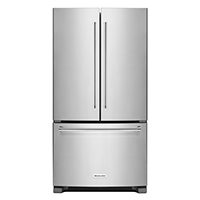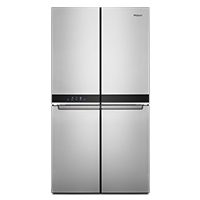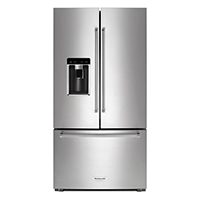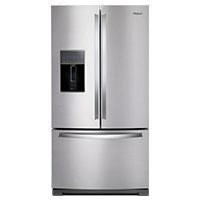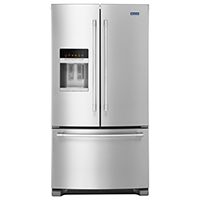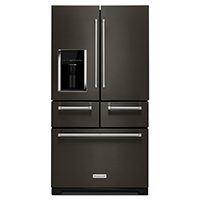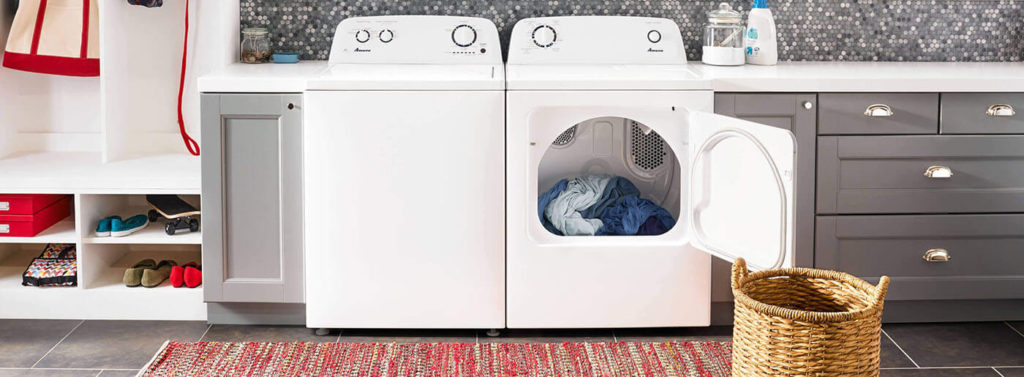Here are some guidelines to help you decide how to buy a fridge that’’ll fit your kitchen and lifestyle perfectly.


Table of Contents

What Size is Best For Your Kitchen and Household?
There isn’t one standard refrigerator size. When shopping for a new fridge, you need to understand the space you have to work with. After deciding where it will go, consider the following:
- Height restrictions
- Width restrictions
- Depth restrictions
- Swing space
- Path of delivery
Before getting too far into shopping for a fridge, measure the area where the fridge will be installed and consider the size that makes sense for your needs.
Here are some key points to consider when measuring your space:
- Take height, width and depth measurements of the cutout where the fridge will stand and compare them to the product’s listed dimensions.
- Make sure to leave space on all sides of the refrigerator to accommodate cords and hoses and provide adequate airflow: at least 1/2 inch (1.3 cm) on the sides and top of the refrigerator and at least 1 full inch (2.5 cm) behind.
- Pay attention to a refrigerator’s depth measurements with the door closed and open to ensure space for a full door swing out without hitting cabinets, walls or an island.
- Measure the doorways and pathways that the refrigerator will travel on its way to the kitchen before installation.
- Some helpful reminders:
- Always follow your appliance use and care and installation instructions, as they are your primary source of information.
- The best advice is to always measure twice!
See this Quick Video Guide on Choosing a Refrigerator to Help Guide Your Search

Free-standing vs. Built-in Refrigerators
Free-standing fridges offer both standard and counter-depth options to meet your style and storage needs. They are typically easier to install and are generally more affordable than a built-in model. Typically, no custom cabinetry is required for free-standing refrigerators. Most common configurations are: Top Mount, Bottom Mount, Side-by-Side and French Door.
Standard-Depth
- A popular choice for families in need of more fridge and/or freezer space.
- The fridge slightly protrudes from the counter.
- Considered to be a more cost-effective option.
- Choose from a variety of options to find one that suits your needs.
Find a refrigerator for your home that balances space, functionality and style.
Counter-Depth
- Gives the appearance of being built in, providing a sleek, seamless style ideal for modern kitchens.
- Offers a built-in look, but often less costly than actual built-in models.
- Allows for optimal traffic flow in the kitchen since the fridge doesn’t stick out. Additionally, it allows for doors to swing wide open without a cabinet or counter getting in the way.
With an almost built-in look, a counter-depth fridge could be the right fit for your kitchen.
Built-in Fridges
Generally, built-in refrigerators are taller than standard models to make up for the space lost in depth. They also typically offer widths up to 48 inches (122 cm) to meet your storage needs.
They come in a variety of styles like French Door, Bottom Freezers and Side-by-Side.
- Commonly designed to more seamlessly integrate with your existing kitchen.
- Often, a costlier option because the fridge is built into cabinets which may require custom designed cabinetry and a professional to perform the installation.
- Can either be a flush or non-flush install. In a flush installation, the front of the refrigerator sits flush or in line with the surrounding cabinetry. With a non-flush install, the doors will protrude slightly from the surrounding cabinetry or countertop.
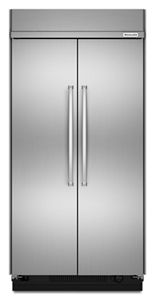
Once you have chosen a size and layout that will work for your kitchen, household and lifestyle, you should start thinking about style. The options listed here all have a freezer but can differ based on where the freezer is located.

Interested in a counter-depth fridge but don’t know if it’s right for you? Take our quick quiz to get some help!
Counter-depth or standard:
Which refrigerator is best for you?

You’ve probably heard of counter-depth refrigerators, often a trendy choice for modern kitchens. But what are they exactly, and are they a better choice for you than a standard-depth fridge?
Take this quick quiz to find the answer.

Do you need to optimize kitchen floor space?
A counter-depth fridge is better for you.
A standard-depth fridge is better for you.
Counter-depth fridges don’t protrude as much from the counter as standard-depth fridges, giving a more uniform and less cluttered look. While the depth of these fridges can vary, they usually measure about 25″, or the depth from the wall to just beyond the edge of the counter.





Do you have a large family?
A standard-depth fridge is better for you.
A counter-depth fridge is better for you.
If capacity is most important for your family, deeper fridges will typically make sense. A standard-depth, (or full-depth) refrigerator has a cabinet design that can be 30″ to 36″, which usually means more capacity.





Do you require easy access to fridge contents?
A counter-depth fridge is better for you.
A standard-depth fridge is better for you.
Being less deep, it’s easier to reach to the back of a counter-depth fridge. But keep in mind, this may reduce overall storage space within your fridge.





Do you need large bins for fruit and vegetable storage?
A standard-depth fridge is better for you.
A counter-depth fridge is better for you.
Some counter-depth models have drawers that stretch across the width of the fridge, offering lots of storage space. More likely, however, they come with narrower and more shallow drawers.





Ready to buy a new fridge?
There are many details to consider, such as the features, finish and style. Our handy Appliance Finder will guide you to your ideal match.
GO TO APPLIANCE FINDERThis is also another opportunity to choose a refrigerator that fits your taste and the current look of your kitchen.

Style / Configuration
Give thought to where you feel a freezer would be most conveniently placed on a fridge.
Top-Freezer Refrigerators
- Freezer is located at the top of the fridge.
- Classic design – generally a lower price point.
- Reversible door option, with the ability to open from the left or right, depending on preference and flow of the kitchen.
- Typical total volume can range from 10-21 cubic feet.
- Usually available in 24″ (61 cm) , 28″ (71 cm) and 30″ (76.2 cm) and 33″ (82.8 cm) widths.
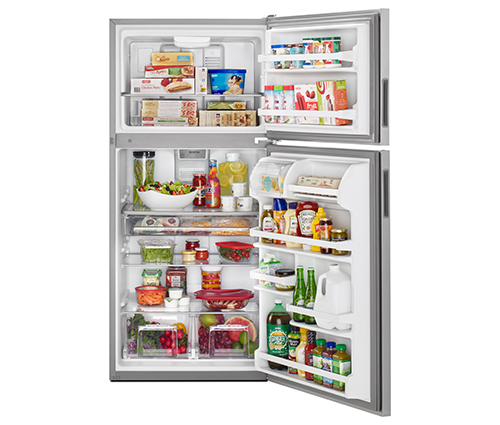
Bottom Freezer Refrigerators
- Freezer is located at the bottom of the fridge.
- Freezer door can swing open from either the left or right or be a pullout drawer style.
- Options for the fridge door to open from either the left or right based on your preference and flow of the kitchen.
- Keeps fresh food at eye level in the refrigerator compartment.
- Typically, a bottom freezer is larger than a top freezer and has tiered storage baskets. This can be useful if you store a lot of frozen foods.
- Usually 19-22 cubic feet of total volume with small space options at 12 cubic feet.
- Usually available in 24″ (61 cm) , 28″ (71 cm) and 30″ (76.2 cm) and 33″ (82.8 cm) widths.
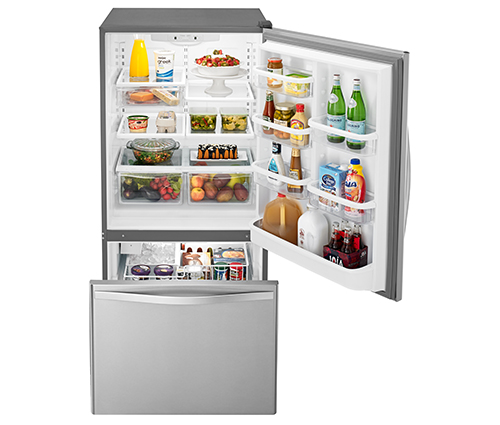
French Door Bottom Freezer Refrigerators
- A typical French door bottom freezer has two doors (that open independently) to access the refrigerator compartment at the top with the freezer located below, that pulls out.
- There are also 4-door and 5-door options available with easy-to-access external drawers. You can store snacks where you can reach them without opening the main doors.
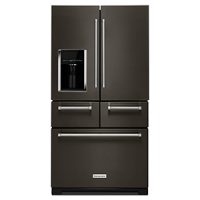
- Designed to allow you to open only one side of the refrigerator at a time. This ensures that the entire fridge compartment doesn’t cool down each time a door is opened.
- Models with two fridge doors are narrower and therefore require less room to open, which can be helpful in a tighter kitchen space.
- French door fridges are considered a higher-end choice because they usually have the most features.
- Pantry-like layout and specialized storage compartments help keep food more visible and accessible.
- Typically 20-28 cubic feet of total volume.
- Usually available in 30″ (76.2 cm), 33″ (83.8 cm) and 36″ (91.4 cm) widths. Select widths also offer counter-depth options.
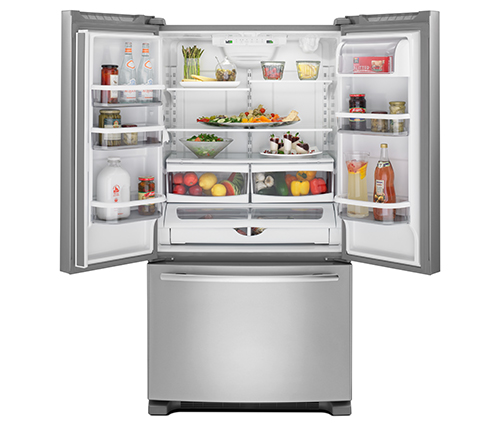
side-by-Side Refrigerators
- Two separate full-height compartments (freezer and fridge), each with its own door.
- Can offer more freezer space (great for families who buy more freezer items).
- Easily access freezer foods.
- Offer adjustable shelves and door bins to help keep everything organized.
- With each compartment’s smaller width capacity, it may make it difficult to fit wide trays and platters.
- Typically 20-26 cubic feet of total volume.
- Usually available in 33″ (83.8 cm) and 36″ (91.4 cm) widths. Select widths also offer counter-depth options.
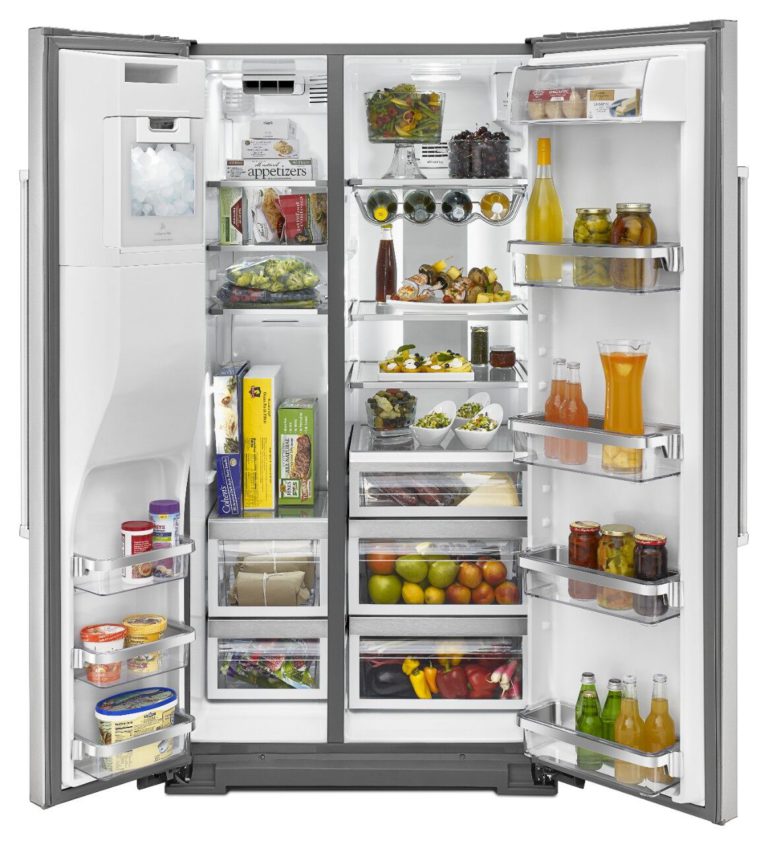
Now that you’ve decided on the size, type and style, it’s time to turn your attention to the finishing touches. What is your preferred finish for your refrigerator? Is matching to the rest of your appliances important? Do you want something that is easier to maintain? Answer these questions to determine your ideal finish!

Finish / Colour
Browse finishes and colour options to find the right fit for your taste and current kitchen design.
Stainless Steel
- Options available for fingerprint resistant finishes, making it easy to clean and maintain.
Black Stainless Steel
- Beautiful modern take on the traditional stainless steel design.
- Options available for fingerprint resistant finishes.
White
- Classic design.
Black
- Classic design.
Panel Ready Built-in
- If you go with a panel ready built-in option, you can customize your refrigerator to match your kitchen panels / cabinet doors.
Finally, you should factor in the number of features you want. Any additions, like having a water and ice dispenser on the fridge’s exterior, can influence the design/style and potentially the cost of a fridge.

Features
Refrigerators offer a wide variety of features. You need to decide which are the most appealing and important to you.
Water and Ice Dispensing
- There are both internal and external dispensing options.
- Internal dispensers are a better option for those who prefer a cleaner look on the exterior of their fridge.
- External dispensers allow for easy access without having to open the fridge.
- Both provide additional convenience of immediate ice cubes and water.
- Most fridges that offer water dispensing are equipped to also house a water filter to provide fresh, clean-tasting water.
- May require a plumber to attach to the water line so factor in that extra cost.
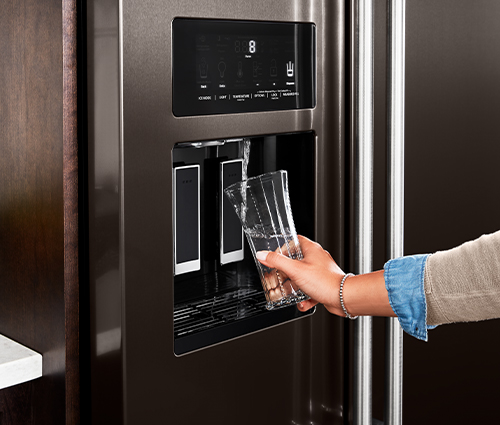

Keep your water tasting great every day with everydrop® water filters.
Performance Features
- Dual evaporators allow for more precise temperature controls, as two evaporators provide independent cooling solutions for the fridge and freezer.
- Humidity controlled crispers create ideal fruit and vegetable environments.
- Adjustable temperature drawers allow you to select a custom temperature based on what you’re storing. Some drawers are even full-width pantry style to accommodate large platters/trays.
Organization Features
- Adjustable shelving/bins provide flexibility when storing items of varying heights like jars of sauces, juice containers, party platters or milk cartons.
- Large gallon door bins offer a deeper door bin to allow for larger items like milk jugs, juice cartons and condiment jars.
- Tiered shelving inside the freezer may improve the storing and retrieval of frozen food items.
LED Lighting
- Helps you easily find food inside your fridge and provides a white light so food looks as it should.
- LED lighting uses less energy than incandescent bulbs.
Smart / Wi-Fi Connectivity
- Some smart fridges can connect with your Wi-Fi and your smart devices, giving you options to troubleshoot issues, get notifications and control smart features right from your phone.
We hope that completing these recommended steps has helped lead you to making a decision on what fridge to buy. At Appliance Answers, we feel that any decision you make will be the right one. Please use our chat function if you require further help. Our aim is to make this process as simple as possible.
Find it here. Explore refrigerator choices for your home from Whirlpool, Maytag and KitchenAid brands.

